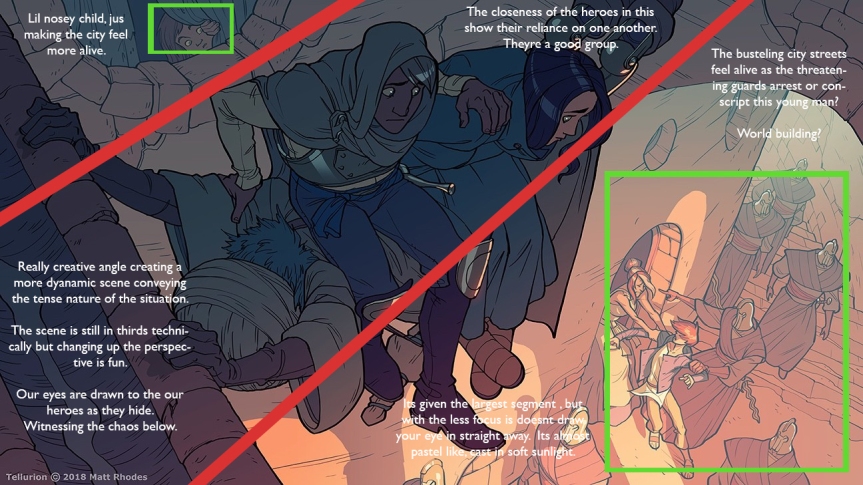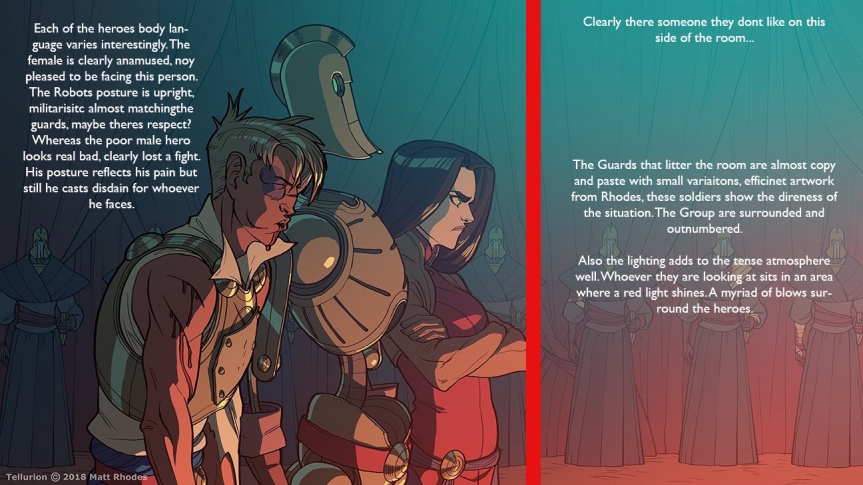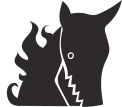Matt Rhodes is an artist that has influenced greatly over the last several years. His work with Bioware is one of the factors that inspired me to go into concept art.
I would like to do a case study of Rhodes’s Personal Project, Tellurion, where he explored Narrative Storytelling with only visuals, allowing the viewer to decipher the scene. He accomplishes this very well by utilizing character design, staging and visual storytelling.
What I want to do is scan through the dozens of pieces he has made, pick out some that I feel I can analyze successfully and write a short study on them. Matt Rhodes Tellurion is a fine example of narrative Story done amazingly. He successfully achieves his goal of telling a story with only visuals to work from. To attempt to build an entire world, characters and story and leave it up to interpretation is such a refreshing task. I believe if I can learn even a tenth of what Rhodes does here it can greatly benefit my project.
What I will now do is go through some of my favourite pieces from his projects, scenes where I feel character relationships and interactions are at their strongest. I also want to review some interesting composition where Rhodes messes with angles and how this influences what the viewer sees.
Its also to note Rhodes attempt at world building with only visuals to help the viewer along. He clearly identifies the “heroes” and the “villains”. In my project Id like to attempt at slight world building so identifying his techniques would be wise.
LINK – https://tellurion.ca/pages/tellurion
Analysis 1 – Exciting Revelation

In this first scene, which I chose due to the interactions between all the characters is a key focus. The first identifiable trait of the composition is how its divided into thirds and each character gets their own segment. The varying sizes of the segments also help draw the viewers focus.
Like the characters in the scene, who are ignoring the female character, the viewer eyes would be naturally drawn the larger figures up front in the scene. Their body language is eye-catching due to their clear excitement over what the female has shown them. But in contrast, the female figure has received the smallest segment as she stands between the two clearly not their focus. It’s a nice way to lead the viewer to her as she is central but not what might catch your eye first. She is clearly key to the scene
Analysis 2 – A Table Discussion

In this scene we see the party interacting with some new faces, seemingly a seafaring group. Interesting notes I have about this scene are that the larger characters take up over having of the scene. With his cartoonishly giant proportions, he casts a large shadow. I like to think the fact the character is so shaded could represent how “in the dark” he is to what the female character is revealing to him.
On the other half of the scene, there are several characters present. However, the female character is the most prominent. She appears the most in focus and lit dynamically. To add her body language and posture are very confident and driven. She steals the scene and her other party members reaction to her actions really sell what she is doing is maybe out of characters or just very surprising.
I also just love this wee mopey crewmate.
Analysis 3 – A Perilous Situation

This scene might be my favourite out of my selection here. Firstly the dynamic nature of the scene is maybe its most eye-catching feature. The scene is still divided into a third but with the angle being so uniform. However, this adds to the nature of the scene as this small army of guards march through the area, forcing the heroes to improvise a hiding spot.
The scene does a great job of world building also as we see these guards either arresting brutally or conscripting this younger man. Even though our attention instantly goes to the heroes their eyes draw ours to the chaos below in the well-lit scuffle.
Another important note here is that the group’s relationship is clearly that of a close group of friends, as one is willing to use their own body as a support, whilst the male keeps his hand on the female keeping her hidden even with her curiosity and pity. Its subtle to show their closeness, it clearly identifies them as a party willing to help each other.
Also, the nosey child peeking through the window makes the city feel more alive, as there are always wandering eyes.
Analysis 4 – Looking Worst for Wear

This piece does well to convey the attitudes of the party in this dire situation as the group have been apprehended.
What first is clear is how each of the individual characters reacts in this situation. The Male character has clearly been in an altercation with the guards wearing his injuries with an angrily as he stares down the off-screen enemy. His posture shows how weak he is as he slumps slightly. I get the interpretation he’s still up to fight if it comes to it. I find it odd the other two don’t seem more concerned for him.
The Robot character is oddly posed in this scene. Their posture is upright and arms are at the side in a very militaristic fashion. To me, this almost displays a type of respect to the off-screen enemy. Very contrasting to the other group members.
And finally, the female character has maybe the most interesting posing. She stands upright, arms crossed with a very displeased look. I get the sense she has a history with the offscreen figure, perhaps a strained relationship. The common theory on the forums is that she’s the daughter of the offscreen figure which could explain her attitude. It’s reminiscent of a disgruntled child.
Interestingly the amount of empty space is actually called “Lead Room” or “Lead Space”. Its a technique used to avoid making the scene feel claustrophobic by leaving enough empty space to imply the character is viewing in the distance of that direction.
In the background of the scene a shade of redcoats a line of soldiers who surround the group. Combined with the red lighting, conveying a sense of danger, the guards pose a clear threat to the party.



































